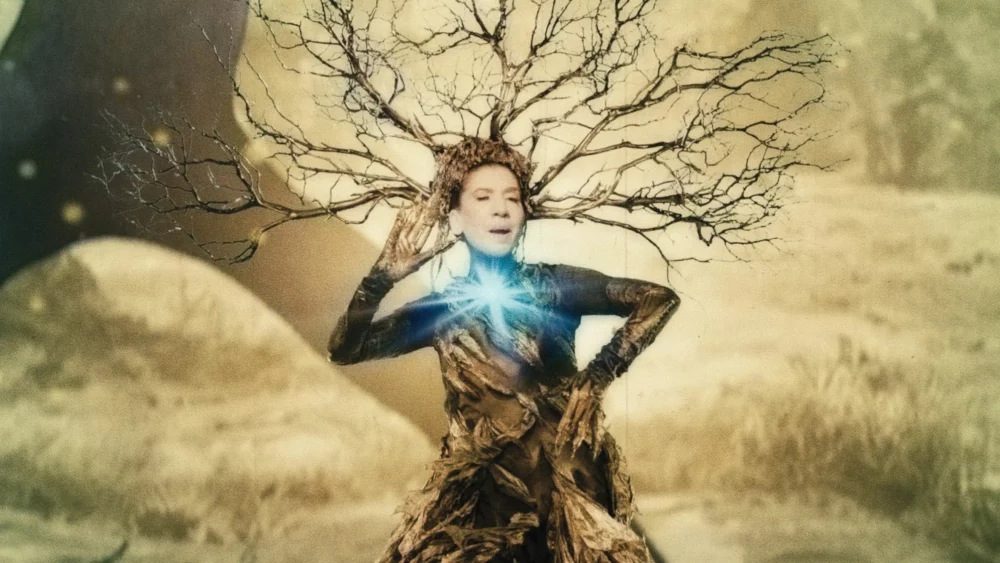
- Source: SLANT
- Author: WILLIAM REPASS
- Date: OCTOBER 8, 2023
- Format: DIGITAL
Once Within a Time Review: Godfrey Reggio and Jon Kane’s Bardic Fantasy of the Real
Once Within a Time is more of a gesture than a chain of events.

Photo: Oscilloscope
Godfrey Reggio and Jon Kane’s Once Within a Time pulses with contradiction. Both technical feat and techno-pessimist fable, this strange brew brims with apocalyptic unease and naïve exuberance in equal measure, marking a departure from the strict documentary mode of Reggio’s Qatsi Trilogy without sacrificing his unmistakable style.
Another wordless film for Reggio (though it contains many indecipherable words), and with a runtime of only 52 minutes, Once Within a Time is more of a gesture than a chain of events, though it arguably lands a little closer to the narrative pole than his previous work. As its starting point, it takes the biblical story of Genesis, with a visual pun connecting the “apple” to digital technology—maybe not knowledge per se, but the incessant barrage of visual information that, for Reggio, obliterates our innocence even as it infantilizes us.
Fenced in by screens, a group of children watch a bewildering array of images. A random sampling includes: an apple-clutching demagogue (Brian Belott) yammering operatically; personified emojis and crash-test dummies executing a danse macabre; giant robots battling flying saucers in an hourglass sandscape of half-buried Exxon tankers and askew powerlines; and an Afrofuturist jazz deity (Mike Tyson) inspiring the children with saxophonic speech.
The realism of celluloid, insofar as it captures and preserves whatever was placed before the camera, is only one of many elements in the film. Reggio and Kane (who edited Naqoyqatsi) push the dialectical montage of the Qatsi Trilogy even farther by collaging not just images, but cinematic genres and visual media. The space of Once Within a Time contains so many screens within screens and frames within frames that it allows for abstract stop-motion animation, an opera sung in nonsense language, archival footage of ostriches racing across the savannah, and a nod to 2001: A Space Odyssey—in the form of man in a white chimp suit (Apollo Garcia Orellana) pulverizing a cellphone—to bleed into one other or play out simultaneously.
The score, meanwhile, though recognizably a Philip Glass composition with all its minimalist interlockings and repetitions, shows just as much the influence of Iranian composer and singer Sussan Deyhim, who contributes additional music and plays the part of a singing anthropomorphic tree. Interspersed with snippets of the non-Western, multicultural instrumentation for which she’s known, the score amplifies the eclecticism of the images.
In keeping with the Genesis framework, Reggio and Kane pack the film with visual throwbacks to the origins of cinema. Irises in and out and intertitles conjure the “innocence” of a time before the rules of the medium had yet to be codified. A reference to the iconic shot of the man in the moon with a projectile in its eye from Georges Méliès’s Trip to the Moon would seem to express Once Within a Time’s allegiance to the magical, theatrical dimension of cinema, as opposed to the Lumière brothers’ documentation of daily life. A return to childlike imagination and pure play, the film suggests, may be the only means of averting—or making bearable—the doom we’ve brought down on ourselves. At the same time, there’s an awareness throughout of the role of the moving image in disinforming or merely distracting us from our culpability.
As an intertitle asks in multiple languages at the close of Once Within a Time, “What age is this: the sunset or the dawn?” In other words, whether we see the film as a bad trip or a good one rests entirely on the individual viewer. Once Within a Time proposes that, in the search for viable alternatives to techno-fascism and climate apocalypse, we might look to the margins of our world, to unfulfilled experiments (including those of cinema) and cultures supposedly left behind by history. It’s still not too late to set ourselves on some other trajectory.

